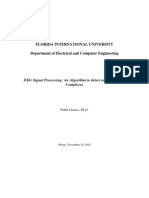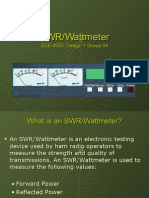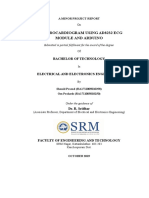Basic Diagno: 7. Basic Diagnostics in Cardiology
Basic Diagno: 7. Basic Diagnostics in Cardiology
Uploaded by
vinaysettyOriginal Title
Copyright
Available Formats
Share this document
Did you find this document useful?
Is this content inappropriate?
Report this DocumentCopyright:
Available Formats
Basic Diagno: 7. Basic Diagnostics in Cardiology
Basic Diagno: 7. Basic Diagnostics in Cardiology
Uploaded by
vinaysettyCopyright:
Available Formats
75
Basic Diagno
7. Basic Diagnostics in Cardiology
Part B 7
Rüdiger Kramme
7.7 Complications ...................................... 84
The term basic cardiology diagnostics refers to
the noninvasive measurement of the cardiac 7.8 Technical Safety Aspects of ECG Systems .. 84
electrical action potential at rest and under
7.9 Long-Term ECG ..................................... 84
stress, in order to assess heart function. Due
7.9.1 Leads.......................................... 84
to technical developments in ECG systems, the
informative value of (basic) diagnostic assess- 7.10 Long-Term ECG Systems......................... 85
ments of the cardiovascular system has improved 7.11 Computer-Based Assessment ................. 85
enormously with ever-increasing accuracy. This
chapter introduces equipment-based diagnostic 7.12 Heart Rate Variability
methods: Sect. 7.1 ECG, Sect. 7.9 Holter Monitoring and Heart Rate Turbulence .................... 87
and Sect. 7.19 Exercise ECG. 7.13 Indications
for Long-Term Electrocardiography ........ 87
7.1 Electrocardiography .............................. 75 7.14 The Significance of the Long-Term ECG ... 87
7.2 Electrocardiograph Equipment 7.15 The Exercise ECG ................................... 88
Technology and PC ECG.......................... 76 7.16 Equipment Technology.......................... 88
7.2.1 Physical 7.16.1 Physical
and Technological Principles.......... 76 and Technological Principles.......... 88
7.2.2 Equipment Classification ............... 77 7.16.2 Ergometry Measuring Station ......... 88
7.2.3 Recording Systems........................ 78 7.16.3 Types of Ergometers...................... 88
7.2.4 Electrode Technology .................... 78
7.2.5 System Properties......................... 79 7.17 Reduced Exercise ECG Leads ................... 89
7.2.6 Operating Modes .......................... 79
7.18 Automatic ST Measuring Programs.......... 90
7.3 ECG Methods ........................................ 79
7.19 Exercise Test ........................................ 90
7.4 Lead Systems........................................ 80 7.19.1 Stress Intensity ............................ 90
7.4.1 Measurements from the Surface
7.20 Methodological Notes ........................... 93
of the Body ................................. 80
7.4.2 Standard Leads ............................ 80 7.21 The Diagnostic Value of Ergometry ......... 93
7.4.3 Augmented and Reduced Leads
7.22 Indications .......................................... 93
from the Surface of the Body ......... 82
7.4.4 Invasive Leads ............................. 83 7.23 Abort Criteria and Safety Measures ......... 93
7.5 Methodological Notes ........................... 83 7.24 Technical Safety Aspects ........................ 94
7.6 The Diagnostic Value of the ECG ............. 83 7.25 Notes on Planning ................................ 94
7.1 Electrocardiography
Electrocardiography (ECG) is a method of recording spatial profiles of the electrical excitation processes in
electrocardiograms – which record the temporal and the myocardium in the form of waves, peaks and lines
R. Kramme et al. (eds.), Springer Handbook of Medical Technology
© Springer-Verlag Berlin Heidelberg 2011
76 Part B Functional Diagnostics Devices
Part B 7.2
Electroarteriogram Electroventriculogram
Nomenclature P wave PQ interval QRS complex ST segment T wave U wave
Electrical heart Depolarization Transition Depolarization Complete Repolarization
activity of atria of ventricles depolarization of ventricles
T 1/8 – 2/3 of R
Q = 0.04 s; <1/4 of R
P < 0.25 mV
R 0.6 – 2.6 mV
S < 0.06 mV
J-point
Isoelectric 0.05 – 0.1 s Isoelectric
line 0.1 s line
PQ time QT duration
0.12– 0.2 s Frequency dependent
Fig. 7.1 Nomenclature of the electrocardiogram (ECG)
(Fig. 7.1) – and performing diagnostic analyses of these face of the body, which make up only a fraction of the
electrocardiograms. potential generated by the heart. The heart is thus inter-
Every instance of depolarization through cardiac preted as a source of potential, so the ECG ultimately
fibres is the source of an electric potential. These provides an image of the generation of electricity (po-
noninvasive measurements generally measure potential tential shift) and reflects the excitation processes in the
differences that occur across an electric field on the sur- measurements selected.
7.2 Electrocardiograph Equipment Technology and PC ECG
Electrocardiographs (ECG devices for short) and PC are set for an ECG preamplifier when compared to usual
ECG modules are diagnostic devices for recording, amplifier technology: interfering high-frequency AC
amplifying, storing, processing, analysing and docu- voltages are attenuated by means of a high-frequency
menting (registering) an electrocardiogram. Noninva- filter upstream of the preamplifier input, so that no
sive electrocardiography has been a standard procedure overamplification or self-excitation can occur. Extreme
for a number of decades, and ECG equipment is there- interference voltages are likewise blocked by means of
fore as good as is mandatory in both hospitals and small discharge sections and antiparallel diodes. A relatively
private practices. high input resistance (generally 10 MΩ and above)
keeps the input currents very low. Capacitively coupled
7.2.1 Physical and Technological Principles mains-frequency AC voltages are eliminated through
high common mode rejection. Following a 20- to 30-
ECG systems are low-noise differential amplifiers; in fold preamplification, the ECG signal is separated from
other words, they consist of a strongly coupled DC am- the direct current via a high-pass filter. The time con-
plifier with a high amplification factor and inverting stant of this filter is 1.5 or 3.2 s. Whereas the processed
(reversed) and noninverting inputs. The output voltage ECG signal is fed to the respective channel ampli-
is a multiple of the voltage present at the input termi- fiers (1 . . . > 12) via an lead selector in analogue ECG
nals. It is the differential voltage of the two voltages equipment, this step is omitted in digital ECG equip-
present at the same pole. Particularly high requirements ment. The recorded signals are instead connected to 12
You might also like
- SERVO-U/SERVO-n Ventilator System Service ManualDocument140 pagesSERVO-U/SERVO-n Ventilator System Service Manualabu75% (4)
- BS 5839 6 Guide 2020 Update Jan 2021Document19 pagesBS 5839 6 Guide 2020 Update Jan 2021ZzzdddNo ratings yet
- CARESCAPE Monitor B650: Clinical Reference ManualDocument210 pagesCARESCAPE Monitor B650: Clinical Reference ManualJonathan Scott100% (1)
- ESR Tester 096kDocument41 pagesESR Tester 096kFabrício AngieneNo ratings yet
- Automatic Control Systems and Components48298Document453 pagesAutomatic Control Systems and Components48298science1990100% (1)
- Lesson 5 ECG BiopacDocument6 pagesLesson 5 ECG BiopacJavier VeintimillaNo ratings yet
- Sreenidhi Institute of Science and Technology - BE - Btech - 2017Document40 pagesSreenidhi Institute of Science and Technology - BE - Btech - 2017Raghavender ReddyNo ratings yet
- My ModulesDocument273 pagesMy Modules1100% (1)
- Functional Description: Sysmex XE-2100 Operator's Manual - Revised July 2007Document40 pagesFunctional Description: Sysmex XE-2100 Operator's Manual - Revised July 2007elom djadoo-ananiNo ratings yet
- Real Time Implementation of Analysis ofDocument9 pagesReal Time Implementation of Analysis ofLilia RadjefNo ratings yet
- Real Rasti 2015Document51 pagesReal Rasti 2015Kanwal SaleemNo ratings yet
- 1 s2.0 S2215016123001954 MainDocument15 pages1 s2.0 S2215016123001954 Mainw_mahmudNo ratings yet
- PhysiologicalMeasurement PDFDocument124 pagesPhysiologicalMeasurement PDF王勋No ratings yet
- Interpreting ECGs in Clinical Practice (PDFDrive)Document119 pagesInterpreting ECGs in Clinical Practice (PDFDrive)Carina AlbertNo ratings yet
- Analysis and Feature Extraction of ECG Signal For Myocardial Ischemia DetectionDocument5 pagesAnalysis and Feature Extraction of ECG Signal For Myocardial Ischemia DetectionerpublicationNo ratings yet
- Detection of Various Diseases Using ECG Signal in Malab: Shital L. Pingale, Nivedita DaimiwalDocument4 pagesDetection of Various Diseases Using ECG Signal in Malab: Shital L. Pingale, Nivedita DaimiwalHarshit JainNo ratings yet
- V List of Tables VI List of Figure VII Chapter 1. Introduction: 1Document46 pagesV List of Tables VI List of Figure VII Chapter 1. Introduction: 1Anonymous UjF07j9l100% (1)
- SpinEDU - Lab - Menual (New With Cover)Document53 pagesSpinEDU - Lab - Menual (New With Cover)石子No ratings yet
- EKG Signal Processing An Algorithm To Detect and Align QRS ComplxDocument33 pagesEKG Signal Processing An Algorithm To Detect and Align QRS ComplxaryakushalNo ratings yet
- EEDesignLabManual v0.9 PDFDocument69 pagesEEDesignLabManual v0.9 PDFMahendra YadavNo ratings yet
- Piezoelectric Accelerometers and Vibration Pre AmplifiersDocument160 pagesPiezoelectric Accelerometers and Vibration Pre Amplifiersavoid11No ratings yet
- BME354 - ECG I, Biopotential Amplfier Advaitha Anne TA: Demi ShenDocument5 pagesBME354 - ECG I, Biopotential Amplfier Advaitha Anne TA: Demi ShenanneNo ratings yet
- Final PresentationDocument21 pagesFinal PresentationGustifa fauzanNo ratings yet
- 5 Identifying ECG IrregularitiesDocument37 pages5 Identifying ECG IrregularitiesRahmat MuliaNo ratings yet
- QRS CancellationDocument94 pagesQRS CancellationNguyễn Trọng TuyếnNo ratings yet
- Department of Electrical Engineering EE363: Power ElectronicsDocument8 pagesDepartment of Electrical Engineering EE363: Power ElectronicsAbrahan ShahzadNo ratings yet
- Tecnel Pe LabDocument159 pagesTecnel Pe LabAhas AlqNo ratings yet
- RLC SeriesDocument5 pagesRLC Seriesladlaawan702No ratings yet
- Eec236 1Document52 pagesEec236 1JosephNo ratings yet
- Eeen 211 Exp 10Document20 pagesEeen 211 Exp 10Alan ShelengNo ratings yet
- Minor Project Report 1Document26 pagesMinor Project Report 1Shanid PrasadNo ratings yet
- 01 - SRV02 User ManualDocument30 pages01 - SRV02 User ManualGargouri SoulaimaNo ratings yet
- Medical Instrumentation ManualDocument54 pagesMedical Instrumentation ManualFLORENCE SHALOMNo ratings yet
- MODUL 5 PRAKTIKUM DASAR SISTEM TELEKOMUNIKASI - RF - (Trainer ERT-RCT-00)Document4 pagesMODUL 5 PRAKTIKUM DASAR SISTEM TELEKOMUNIKASI - RF - (Trainer ERT-RCT-00)RIZKI AFANDI RAMBENo ratings yet
- Circuit ExperimentDocument6 pagesCircuit ExperimentChris GarciaNo ratings yet
- General Signal ConditioningDocument20 pagesGeneral Signal ConditioningkhadidjaNo ratings yet
- User Manual: Rotary Motion Servo Plant: SRV02Document30 pagesUser Manual: Rotary Motion Servo Plant: SRV02T KaripNo ratings yet
- Ecg Signal Thesis1Document74 pagesEcg Signal Thesis1McSudul HasanNo ratings yet
- NWCA StudyGuide CET 1 060117Document9 pagesNWCA StudyGuide CET 1 060117Fernando AlmaguerNo ratings yet
- Ch07EN CalibrationsDocument48 pagesCh07EN CalibrationsHermeson SantiagoNo ratings yet
- Electrocardiogram (Ecg) Signal Processing On Fpga For Emerging HeDocument7 pagesElectrocardiogram (Ecg) Signal Processing On Fpga For Emerging Hekaavyaa.ram63No ratings yet
- Control of A Dynamic Voltage Restorer To Compensate Single Phase Voltage SagsDocument118 pagesControl of A Dynamic Voltage Restorer To Compensate Single Phase Voltage Sagsanon-510615No ratings yet
- Ecg SimulatorDocument4 pagesEcg SimulatorzorgglubNo ratings yet
- Handbook Measurements On PV SystemsDocument56 pagesHandbook Measurements On PV Systemsphz7ym4gmyNo ratings yet
- F6150 IeeeDocument1 pageF6150 IeeeEduardo MacariosNo ratings yet
- Jetircj06098 PDFDocument3 pagesJetircj06098 PDFSucharita MitraNo ratings yet
- Loose Core Diagnostic MethodsDocument16 pagesLoose Core Diagnostic MethodsandikaubhNo ratings yet
- Protection Services BrochureDocument2 pagesProtection Services BrochureEngr Irfan AkhtarNo ratings yet
- Caretium Xi921cDocument48 pagesCaretium Xi921cahmad nur Fauzi100% (1)
- Edc Lab Manuals1Document78 pagesEdc Lab Manuals1sowmiyaNo ratings yet
- Piezoelectric Accelerometers and Vibration PreamplifierDocument160 pagesPiezoelectric Accelerometers and Vibration PreamplifierBogdan Neagoe100% (1)
- Down 20120215053636663Document6 pagesDown 20120215053636663Alexis Jonathan Bautista BaqueroNo ratings yet
- IC U509 TAB T210 STc3115Document35 pagesIC U509 TAB T210 STc3115Raul AlfaroNo ratings yet
- Matlab Implementation of Pan Tompkins ECG QRS Detector.: 1 BackgroundDocument3 pagesMatlab Implementation of Pan Tompkins ECG QRS Detector.: 1 BackgroundRabah AmidiNo ratings yet
- 20uec153 DC Lab 4Document16 pages20uec153 DC Lab 4ANUJ GUPTANo ratings yet
- MSD AssignmentDocument16 pagesMSD AssignmentNanda KishoreNo ratings yet
- Professor Modisette What Are Oscilloscopes?: ECE 206LDocument13 pagesProfessor Modisette What Are Oscilloscopes?: ECE 206Lapi-437430069No ratings yet
- Introduction To OscilloscopesDocument18 pagesIntroduction To Oscilloscopesjosearrietaco100% (2)
- 2ICMEETGITAMDocument12 pages2ICMEETGITAMTrương Vỉ BùiNo ratings yet
- Inductively Coupled Plasma Spectrometry and its ApplicationsFrom EverandInductively Coupled Plasma Spectrometry and its ApplicationsSteve J. HillNo ratings yet
- Video Consent and Release Form: SignatureDocument1 pageVideo Consent and Release Form: SignaturevinaysettyNo ratings yet
- Fire Exit: Notes: Date 4.6.19Document1 pageFire Exit: Notes: Date 4.6.19vinaysettyNo ratings yet
- Namburi Aditi Biodata PDFDocument1 pageNamburi Aditi Biodata PDFvinaysettyNo ratings yet
- GreenShield - DhawalJain - 1 PDFDocument15 pagesGreenShield - DhawalJain - 1 PDFvinaysettyNo ratings yet
- Medical Device Reporting21 CFR Part 803Document26 pagesMedical Device Reporting21 CFR Part 803vinaysetty100% (1)
- Minimum Electrical ClearanceDocument31 pagesMinimum Electrical Clearanceger8050% (2)
- HVDC Rihand-DadriDocument1 pageHVDC Rihand-Dadrimayank9390No ratings yet
- 45relay Rm4uaDocument1 page45relay Rm4uapedrovicentexNo ratings yet
- A Universal Remote Control With Haptic InterfaceDocument6 pagesA Universal Remote Control With Haptic Interfacesharmili_arvetiNo ratings yet
- 5G Millimeter Wave Channel Model Alliance Measurement Parameter and Scenario Parameter List - NYU WIRELESSDocument42 pages5G Millimeter Wave Channel Model Alliance Measurement Parameter and Scenario Parameter List - NYU WIRELESSyassirajalilNo ratings yet
- Brake Failure Indicator-1Document8 pagesBrake Failure Indicator-1Tom TomNo ratings yet
- CH 6Document26 pagesCH 6Hammad SaleemNo ratings yet
- Kidde - Manual Pull StationDocument9 pagesKidde - Manual Pull Stationlance boxNo ratings yet
- Ee 402-Special Electric MachinesDocument65 pagesEe 402-Special Electric MachinesharithaNo ratings yet
- The Honest Academy Name: - Sheet No.Document2 pagesThe Honest Academy Name: - Sheet No.danial ahmadNo ratings yet
- Chiller Tonillo Daikin WGS190A - Technical Data SheetDocument2 pagesChiller Tonillo Daikin WGS190A - Technical Data SheetMatthew OlsenNo ratings yet
- 2018-SAC-LATAM-SPEC60Hz - AM040MXMKKC - EA CONDENSADORADocument3 pages2018-SAC-LATAM-SPEC60Hz - AM040MXMKKC - EA CONDENSADORAFabian HernandezNo ratings yet
- Fault Calculation Duhail Annex 1Document13 pagesFault Calculation Duhail Annex 1S Naved MasoodNo ratings yet
- SMC7000HVDocument4 pagesSMC7000HVKirsten HernandezNo ratings yet
- Warnings: Device Usage and Operation SequenceDocument9 pagesWarnings: Device Usage and Operation Sequencemohammedalathwary100% (1)
- CV of Arafat HossainDocument2 pagesCV of Arafat Hossainনির্জন পথিকNo ratings yet
- Ca132026en Fco Upto27kvDocument16 pagesCa132026en Fco Upto27kvHopNo ratings yet
- My Portfolio: Engr. Wilfredo P Purisima Jr. LICENSED NO. 0068441 Licensed Electrical EngineerDocument16 pagesMy Portfolio: Engr. Wilfredo P Purisima Jr. LICENSED NO. 0068441 Licensed Electrical Engineerwil purisimaNo ratings yet
- First Sem SyllabusDocument2 pagesFirst Sem SyllabusretheeshvkmNo ratings yet
- HP Ups 600va Battery Backup & Surge Protection For Home ComputersDocument1 pageHP Ups 600va Battery Backup & Surge Protection For Home ComputersKishan NpNo ratings yet
- Boq AtsDocument1 pageBoq AtsMHD FAJRINo ratings yet
- 90.1254 - 013 WF As BuiltDocument42 pages90.1254 - 013 WF As BuiltKusha SatapathyNo ratings yet
- Ecgr2155 Experiment 5 Parallel and Series Parallel Circuit CharacteristicsDocument7 pagesEcgr2155 Experiment 5 Parallel and Series Parallel Circuit Characteristicsحميم احمدNo ratings yet
- CAMFFU AC FabSafeDocument1 pageCAMFFU AC FabSafehenrycamfilNo ratings yet
- Measurement of Specific Heat Capacity of Water by An Electrical Method ApparatusDocument2 pagesMeasurement of Specific Heat Capacity of Water by An Electrical Method ApparatusYousef KareemNo ratings yet
- ALSTOM Reverse Power Relay CCUM 21 High ResDocument4 pagesALSTOM Reverse Power Relay CCUM 21 High ResArun KumarNo ratings yet






























































































